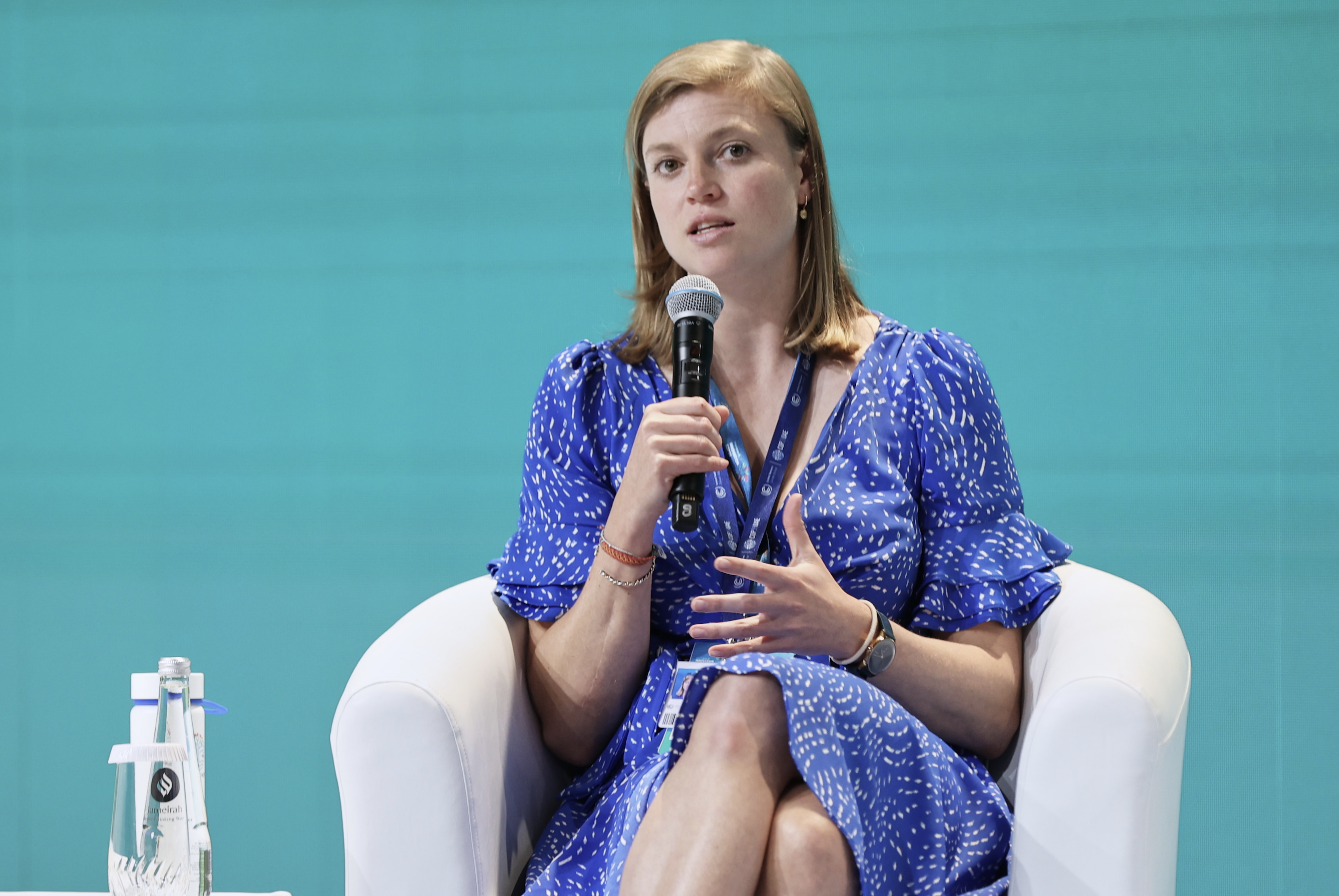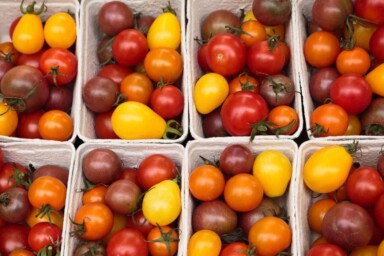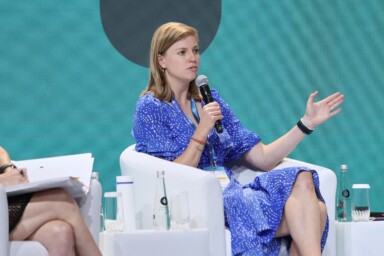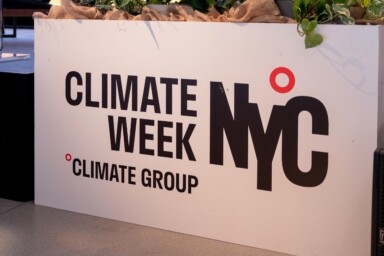The SFT’s Executive Director, Adele Jones, reports back from her time at COP28. Adele shares her reflections on this year’s conference, considering what needs to happen once the ‘strange bubble’ of COP has popped and easy words must be followed with committed action on food and farming.
As the dust settles on COP28, I thought it would be worth sharing some reflections on a very interesting couple of weeks.
I have to say, I was sceptical before heading out, worrying that we were going to have the same conversations with many of the same people, just in somewhere sunny and a bit controversial.
Mostly that was not the case, thankfully. It was a very busy, productive and actually pretty hopeful week in Dubai for the world of food and farming. For obvious reasons, the atmosphere was a little strange and the international media never really knew whether it was coming or going in its stance on the UAE presidency, with the big conversations about phasing out versus phasing down of fossil fuels rightly dominating.
Food and farming on the agenda
However, importantly, food and farming was, finally, on the agenda. Over 160 countries signed the food systems declaration on the 4th of December, representing the first time the topic has made it into the formal COP negotiations (although since typing this, it appears these negotiations didn’t get too far before they once again stalled which is worrying – let’s hope they really are just temporarily stuck rather than stalled for good).
There were other key announcements during the week, including:
- From the 150+ non-state actors who came together around a shared agenda to transform food systems.
- Over $2.5bn worth of financial commitments to support the implementation of the Declaration on Sustainable Agriculture, Resilient Food Systems and Climate Action.
- Twenty-five leading philanthropies issued a joint call for a step-change in funding for regenerative and agroecological approaches, which currently receive just $44bn of the $250-430bn they need.
- The launch of the COP28 Declaration on Climate and Health, which again represents the first time this topic has formally been on the agenda.
- A food loss and waste roadmap detailing more than $300m in ready-to-fund investments in seven pivotal countries.
- The launch of COP28’s Action Agenda on Regenerative Landscapes. This is a collaborative corporate platform to put large-scale agricultural landscapes on a regenerative path ahead of COP30.
Amongst many more!
Particularly significant for us was the announcement of Regen10’s Zero Draft Outcomes-Based Framework. This framework is the result of in-depth analysis of more than 150 existing frameworks, which highlighted the Global Farm Metric (GFM) as the most holistic, outcomes-based, farm-level framework that prioritised the collection of primary data useful to the farmer. As such, the GFM has formed the basis of this zero draft framework, which will be trialled in countries all over the world in the coming year.
What made this COP different?
A key differentiating factor between this COP and others in the past, was the fact that government, NGO and private sector conversations were all much more joined up. This was aided by the way things were laid out, which this year meant that the blue zone (state actors) and green zone (non-state actors) were located right next to each other, rather than completely separate, which allowed for a significant amount of cross fertilisation of conversations and ideas.
Linked to this, my next observation was that whilst there’s still a long way to go, the private sector has really stepped up. As many of you know, we have been involved in the Sustainable Markets Initiative for a while now, working with many of the world’s largest food companies and financial institutions on the future of sustainable agriculture. More recently, these discussions have focused on financing the agricultural transition (watch our session on this theme here), underpinned by common, robust and transparent measurement. See the SMI report outlining the draft financial model that launched this week.
The big question for me though, is how we make progress fast on financing the urgently needed agriculture transition, whilst operating within the constraints of a global economic system which is dishonest and unjust. In the words of Helmy Abouleish of SEKEM during one of the Future Economy Forum events, “we must…use the system to beat the system” and start to reward farmers for the positive impacts they are delivering, whist at the same time working to embed the principles of true cost accounting within government and business circles to ensure we value our environmental and social assets appropriately. There is, of course, an ongoing argument about what should and shouldn’t be monetised (cultural / indigenous knowledge for example), but as stated during the session by Hunter Lovins from the Future Economy Forum, at the moment, not valuing these things means that in the eyes of decision makers, they will continue to have a value of zero.
Thankfully, there are people already on this journey to ‘beating the system’. In my COP reflections blog last year, I talked about SEKEM and how they are finding ways to provide financial incentives to farmers delivering carbon benefits. Since then, SEKEM have not only cemented this with the Egyptian Government – who are now one of the first countries in the world to include carbon credits for organic and biodynamic farmers in their balance sheet – but are also exploring the option of rewarding farmers for nature and social benefits to drive a truly holistic farming transition. We will be piloting the GFM with SEKEM next year.
Another amazing case study is the Community Managed Natural Farming project in India, led by Vijay Kumar in Andhra Pradesh, which is working to transition the lives of smallholder farmers (with an emphasis on women) through peer-to-peer learning and the re-direction of government subsidies. In the last seven years they have onboarded 6 million farmers over 8 million acres impacting over 50 million people – helping them transition to regenerative farming techniques.
Finally, in Australia the Farming for the Future project is working with a network of farmers to drive a transition to production systems which deliver for nature, climate and health, whilst also being more profitable. This process involves building robust evidence to demonstrate the relationship between enhanced natural capital and farm profitability for core production.
The train really has now left the station on food and farming, and the real work starts now to keep new and emerging projects on track. Despite many of the optimistic conversations I have had over the last two weeks, I did also hear some of the old rhetoric creeping in on things like ‘all livestock is bad’ and ‘embracing tech is the only solution’. Ultimately, the answer to fixing food and farming involves many solutions, many different people and the ability to learn from examples of where things are working in the real world, using these to catalyse and inspire change elsewhere.
Where next?
COP is strange bubble, but I leave encouraged by the practical nature of conversations about next steps. Looking ahead to COP29, which, after some intense political jostling, has been confirmed as being hosted by Azerbaijan, my sense is that it is likely to be slightly smaller, with less of the fanfare and more focused on the negotiations, which I think could be a good thing.
The big build up now is to COP30 in Brazil. By then, we have to have some of the solutions we have been discussing, including financing agriculture in a different way and the phase-in of true cost accounting in the real world – both of which depend upon the adoption of a common framework for measuring impact.
COP30 must be about showcasing, learning from and working out how to scale the things we are already doing, rather than rhetoric and commitments in words. After all, by then, we will be at the end of 2025, with just four harvests left to go until we hit – or miss – those aspirational 2030 targets.







